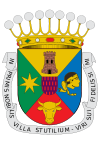Astudillo, Palencia
You can help expand this article with text translated from the corresponding article in Spanish. (December 2012) Click [show] for important translation instructions.
|
Astudillo | |
|---|---|
Municipality | |
| Country | |
| Comarca | El Cerrato, Tierra de Campos |
| Autonomous communities of Spain | |
| Province | |
| Government | |
| • Mayor | Luis Santos González (PP) |
| Area | |
| • Total | 122.95 km2 (47.47 sq mi) |
| Elevation | 780 m (2,560 ft) |
| Postal code | 34450 |
| Area code | 979 822 |
| Website | Astudillo Town Council |
Astudillo is a Spanish municipality in the autonomous community of Castilla y León belonging to the province of Palencia. It is located 29 km northeast of the provincial capital, and has 1,106 inhabitants (2011) with an area of 122.95 km².
Toponym
There are several hypotheses that attempt to explain the origin of the name of the village. According to some, the name Astudillo comes from Roman times, specifically from Estatilio Tauro, the Roman general whose legions had their field operations in this Vaccaei region around the year 29 BC. Others associate it with the Asturians, settlers who came from the north with King Alfonso III "the Great" in the 9th century. Yet another theory associates the name Astudillo with the "small study" that bishop Conancio moved from Palencia to Astudillo, also around the 7th century.
Scholars of toponymy have their theory: apparently the origin of the name of the town is associated with Vascones and Celtic roots (atd = rock, tude = cave, shelter), with the Latin diminutive ellum would produce the meaning "small shelter in the hills".
History

Astudillo has ancient origins, Roman remains having been found within its surroundings. In the Middle and modern ages it was involved in textile production.
As a single town, Astudillo was one of the fourteen villages that made up the Castrojeriz district, which formed the Burgos commune, in the period between 1785 and 1833. In the 1787 Floridablanca Census, Astudillos fell under the ordinary jurisdiction of the Mayoralty lordship.
Astudillo was head of the judicial district from 1834 until the 1970s.
Politics
| Term | Name of Mayor | Political Party |
|---|---|---|
| 1979–1983 | Luis Alberto Nebreda | Union of the Democratic Centre (Spain) |
| 1983–1987 | Luis Alberto Nebreda | Popular Alliance (Spain) |
| 1987–1991 | Glicerio Castro, from 1988 María Soledad Varela |
PSOE |
| 1991–1995 | Eugenio Duque Bustillo | Popular Party (Spain) |
| 1995–1999 | Eugenio Duque Bustillo | Popular Party (Spain) |
| 1999–2003 | Agustín Manrique González | PSOE |
| 2003–2007 | Luis Santos González | Popular Party (Spain) |
| 2007–2011 | Luis Santos González | Popular Party (Spain) |
| 2011– | Luis Santos González | Popular Party (Spain) |
Demography
Population
| 1842 | 1857 | 1860 | 1877 | 1887 | 1897 | 1900 | 1910 | 1920 | 1930 | 1940 | 1950 | 1960 | 1970 | 1981 | 1991 | 2001 | 2011 | |||||||||||||||||
|---|---|---|---|---|---|---|---|---|---|---|---|---|---|---|---|---|---|---|---|---|---|---|---|---|---|---|---|---|---|---|---|---|---|---|
| 451 | 4.396 | 426 | 326 | 373 | 312 | 080 | 286 | 503 | 768 | 259 | 263 | 222 | 910 | 623 | 374 | 127 | 106 |
Economy
Astudillo's main activity include agriculture, the food industry and electricity production. There are several wind farms around the village, along with a 1 MW photovoltaic system and some other smaller ones.
Famous residents
- Juan de Tapia, guerrilla fighter.
- César Arconada, writer and journalist born in Palacios del Alcor.
- Marcelino García Velasco, poet and academian of the Institución Tello Téllez de Meneses born in the Palencia capital, but spent his childhood in Astudillo.
- Carlos Bustillo, journalist.
References
Bibliography
- Castrillo Martínez, Maximiliano (1877). Opusculo Sobre la Historia de la Villa de Astudillo (Booklet on the history of the Villa de Astudillo) (in Spanish). Editorial Maxtor.España. ISBN 84-95636-04-2.

